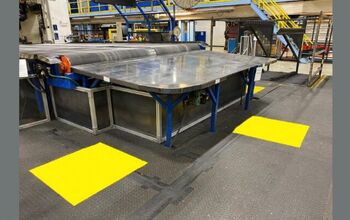Scuderi Split-Cycle Engine To Go On Sale
Last month we told about Ricardo's 2-Stroke/4-Stroke breakthrough, a very promising technology for sure, but one that is still just a series of gleams in a bunch of engineers' eyes. Much closer to prime time is the Scuderi Group's Split-Cycle engine. How close? Motor Authority is citing Automotive News who's claiming Scuderi's tech will be for sale within 12 months. This is big news, as the Split-Cycle internal combustion engine will be 40% efficient, compared to regular 4-cycle mills which are only 33% efficient. Scuderi is also promising lower emissions of NOx. So, how's it work? Just like it sounds, actually. The four-strokes of the Otto-cycle are split across two cylinders. One cylinder is used to compress the fuel and then "gas passages" move the compressed mixture into the detonation or power cylinder. The fun comes when you start playing with the bore and stroke of the various cylinders. For instance, you can make the power stroke longer than the compression stroke to take advantage of the Miller Effect (less energy is used by the compression cycle than the power cycle). Or you can increase the size of the compression piston to in effect supercharge the fuel mixture. We say not a moment too soon, as clean alternatives continue to (not) sputter along.


































Comments
Join the conversation
Why not rotary valves? http://www.coatesengine.com/
Ah, I think you need to reread the article. It will be available for licensing to a manufacturer in 12 months, and prototypes will be available in 'by next year'. That puts it at about 5 years from production, if there are no major problems.
I actually think it makes sense! Why - because of the "Miller effect" - conventionally the expanding hot gases are not allowed to give their full "umph" to the power piston, hence the "pop" and rush of hot exhaust gases out the exhaust valves, and the energy remaining causes the manifold to get broiling hot, and the upper pipes. This way, the full piston travel is possible, getting the best work use out of the hot gases. It just seems logical - we should be able to get more than 1/3 of the energy out of an IC engine, and perhaps other methods add complexities or components with lower reliability. If the other methods are better, why are they not more widely accepted? If the combustion chamber were ceramic lined, the lining may be insulated/heat reflective, and prevent energy on the hot side escaping to the surrounding metal, thereby increasing efficiency. And if the combustion temperature and compression were increased, this may be worth it, even if NOx emissions are an issue - they're high-energy compounds, so a catalyst should be able to handle them easily. But looking broadly at mileage, the low-hanging fruit are engine efficiency, aerodynamics, vehicle weight, and braking, about in that order, give or take the type of vehicle. Improve all four, and we can achieve 120 mpg - seems like we should be there already!
An interesting concept, but without a working prototype, it is impossible to compare efficiency with conventional engines. Also, the compressor means more maintenance and a high efficiency air filtration system. The cost for manufacturing this engine will also be a major factor.